
Butler is an unincorporated community in Baltimore County, Maryland, United States. It is bordered to the west by Glyndon, to the east by Sparks, to the south by Cockeysville and to the north by Upperco. It is often referred to as "Worthington Valley". For almost a century, Butler has served as home to many equestrian events, including the Grand Nationals and the Hunt Cup.
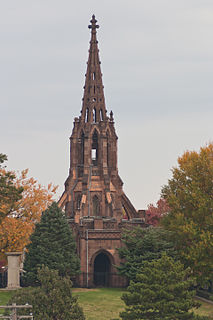
John Rudolph Niernsee was an American architect. He served as the head architect for the Baltimore and Ohio Railroad. Rudolph also largely contributed to the design and construction of the South Carolina State House located in Columbia, South Carolina. Along with his partner, James Crawford Neilson, Rudolph established the standard for professional design and construction of public works projects within Baltimore and across different states in the United States.

Lansdowne Christian Church was established in 1903 in Lansdowne, Maryland. Part of the Christian Church denomination, Lansdowne Christian Church is located at 101 Clyde Avenue, Lansdowne, Baltimore, Maryland 21227 in southwest Baltimore County, on the southwestern outskirts of the City of Baltimore. Rev. J. B. DeHoff was the first pastor in the early 20th century. The church is currently led by the Rev. Trent Owings.
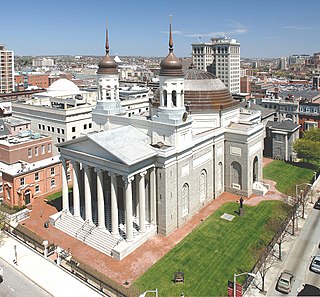
The Cathedral Hill Historic District is an area in Baltimore, Maryland. It lies in the northern part of Downtown just south of Mount Vernon. Roughly bounded by Saratoga Street, Park Avenue, Hamilton Street, and St. Paul Street, these 10 or so blocks contain some of the most significant buildings in Baltimore. The area takes its name from the Basilica of the Assumption which sits in the heart of the district. Despite the number of large religious structures in the area, the district's buildings are primarily commercial in character, with a broad collection of significant commercial structures ranging in date from 1790 to 1940.

The Epiphany Chapel and Church House is a historic church at Odenton, Anne Arundel County, Maryland, United States. It is a two-story gable-roofed frame building constructed in 1918 and laid out in cruciform plan in the Arts and Crafts style. It is significant for its association with the mobilization of the United States military for World War I, since it was constructed adjacent to Camp Meade, a major training camp for troops bound for the Western Front in Europe. Its design was an early work of the prominent Baltimore architect Riggin T. Buckler (1882-1955) of the partnership/firm of Sill, Buckler & Fenhagen.

St. Mary's Episcopal Church, also known as the Church of St. Mary the Virgin, is an historic rectangular-shaped Carpenter Gothic style Episcopal church located at 5610 Dogwood Road in Woodlawn, Baltimore County, Maryland. Designed by the Baltimore architectural firm of Dixon and Carson, it was built in 1873. Its steeply pitched gable roof, board and batten siding, lancet windows and arched side entry way are all typical features of Carpenter Gothic churches.
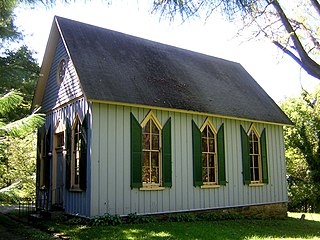
St. John's Church is a historic A.U.M.P. church located in Ruxton, Baltimore County, Maryland.

St. Michael's Church, also known as St. Michael's Chapel and Hannah More Chapel, is a historic Episcopal Church located at Academy Lane and Reisterstown Road in Reisterstown, Baltimore County, Maryland. It is a small, Carpenter Gothic-style, board and batten frame structure, featuring a simple bell-gable. It was designed by New York architect John W. Priest (1825-1859), and constructed about 1853. It was named after Hannah More. It was deconsecrated on May 12, 1978.
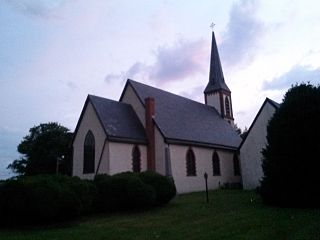
St. Stephen's Episcopal Church is a historic Episcopal church located in Earleville, Cecil County, Maryland.

Knoxville is an unincorporated community in Frederick and Washington counties, Maryland, United States. The Robert Clagett Farm and Magnolia Plantation are listed on the National Register of Historic Places.

Madison Avenue Methodist Episcopal Church, now known as Douglas Memorial Community Church, is a historic Methodist Episcopal church located at Baltimore, Maryland, United States. It is a brick, Greek Revival, temple-fronted structure featuring four fluted Corinthian columns and built 1857–1858. The rear addition is a two-story Colonial Revival style wing dating from about 1900.
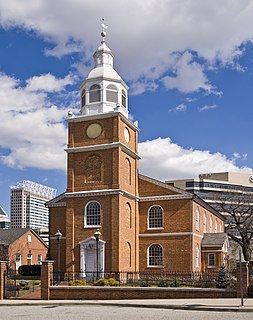
Otterbein Church, now known as Old Otterbein United Methodist Church, is a historic United Brethren church located in Baltimore, Maryland, United States. The first "German Reformed" church was built to serve the German Reformed and some Evangelical Lutheran immigrants, and later entered the Brethren strain of German Reformed Protestantism in the later Church of the United Brethren in Christ.

Grace-Hampden Methodist Episcopal Church is a historic Methodist Episcopal church located at Baltimore, Maryland, United States. It is a large stone building constructed in 1899. The Romanesque Revival-style church features multiple gables and a square bell tower and masonry construction utilizing local granite with round-arched openings and decorative sill and lintel courses. It was the first ecclesiastical commission of local architect George Clifton Haskell.

Lovely Lane United Methodist Church, formerly known as First Methodist Episcopal Church, and earlier founded as Lovely Lane Chapel is a historic United Methodist church located at Baltimore, Maryland, United States.
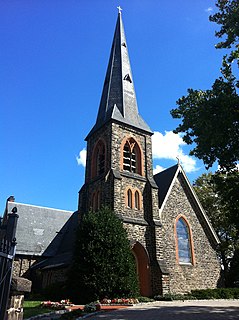
St. John's Episcopal Church, also known as St John's in the Village, is a nineteenth-century Episcopal church building on Old York Road in the former village of Huntingdon (now the community of Waverly in northeast Baltimore, Maryland, United States. The congregation is often referred to as "St. John's of Huntingdon Episcopal Church". It is a Gothic Revival structure built originally in 1847. Also on the property is a cemetery.

St. Luke's Church, is a historic Episcopal church located in Baltimore, Maryland, United States. It is a Gothic Revival-style church that follows the dictates of the Ecclesiological Society reflecting English medieval building principles. It is composed of a tall nave, flanked by side aisles below a clerestory, and features a crenelated tower with lancet windows. Rose windows exist at the west end of the nave and along the clerestory. It was the largest Episcopal church in Baltimore upon its completion in 1851.

Bankard-Gunther Mansion is a historic home located at Baltimore, Maryland, United States. It is a three-story, three bay wide, nine bay deep, flat roofed brick building built in 1866. It is a richly embellished Italianate style building built originally for Jacob J. Bankard, one of many enterprising and prominent butchers who flocked to "Butcher’s Hill", and later George Gunther, who established the Gunther Brewing Company in Baltimore. In 1919 the building became an important Baltimore charitable center to be used by the Hebrew Home for Incurables and the Emmanuel Center to provide humanitarian service to the community.

Douglass Place is a group of historic rowhouses located at Baltimore, Maryland, United States. Built in 1892, it represents typical "alley houses" of the period in Baltimore, two narrow bays wide, two stories high over a cellar, with shed roofs pitched to the rear. Italianate influence is reflected in their segmental-arched window and door openings, and in the simple molded sheet metal cornices which crown the buildings. Frederick Douglass (1818-1895) constructed the five buildings as rental housing for blacks in the Fells Point area of Baltimore, where he had resided from the 1820s to 1838. The site was the location of the Dallas Street Station Methodist Episcopal Church, which he had attended while living in the area.

Zion Lutheran Church, also known as the Zion Church of the City of Baltimore, is a historic Evangelical Lutheran church located in downtown Baltimore, Maryland, United States, founded 1755.

Lafayette Square, is a historic city park and district in the Sandtown-Winchester area of West Baltimore, Maryland. It is bounded by Lanvale Street and Lafayette, Arlington, and Carrollton Avenues.

























